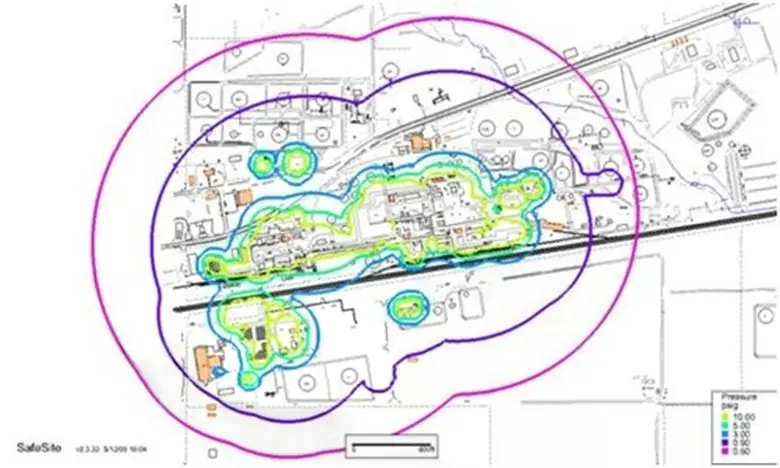Process Safety Management (PSM) requires facility siting to be addressed in an organization’s Process Hazard Analysis (PHA). Facility Siting focuses on the impact of potential fire, explosion, or toxic incidents relative to permanent and temporary buildings intended for occupancy. The purpose of a Facility Siting Study (FSS) is to ensure the risk inside the building is no greater than the risk outside. Thus, facility siting not only provides for a fundamental aspect of risk management, but also a key component in ensuring inherently safer design.
Determining potential consequences posed by facility operations is a necessary step in the process of developing a comprehensive safety plan. A facility siting study assesses potential explosion, flammable, and toxic consequences. Facility siting study results identify hazard vulnerabilities to aid with identification of potential mitigation strategies.
Examples of mitigation strategies to be considered include occupancy reduction, upgrading a building’s blast resistance, building relocation to areas less susceptible to damage, installing flammable or toxic gas detection with automatic or manual ventilation shutdown, providing personnel protective equipment, etc.
iFluids documents each facility siting study in a report that defines inputs, explains calculation methods, provides interim calculation results to allow verification and validation of the methods employed, and summarizes results in a range of meaningful forms. Composite contour plots of overpressure, flammability, and toxicity define key endpoints and provide an overview of areas vulnerable to impacts from assessed hazards.

3-D view of modeled release over a refinery
At the conceptual design phase of a project to assist with decisions such as layout of process equipment and buildings.
At the detailed design phase to identify potential issues with plant layout, building locations and structural blast resistance, and mitigation system design.
During operations to evaluate consequences and provide results that help identify potential mitigation strategies.
Suggested a phased approach to Facility siting:
Step 1: Screening evaluation to determine which occupied buildings (permanent or temporary) are impacted by significant consequences.
Step 2: Evaluation to determine risk associated with occupied buildings.
Step 3: For buildings exceeding acceptable risk criteria, detailed consequence modeling to remove conservatism and re-evaluate the risk.
Step 4: For buildings still exceeding acceptable risk criteria, evaluation of available mitigation strategies such as, relocation of building, people or equipment, structural improvements to occupied buildings, fire or explosion mitigation strategies.